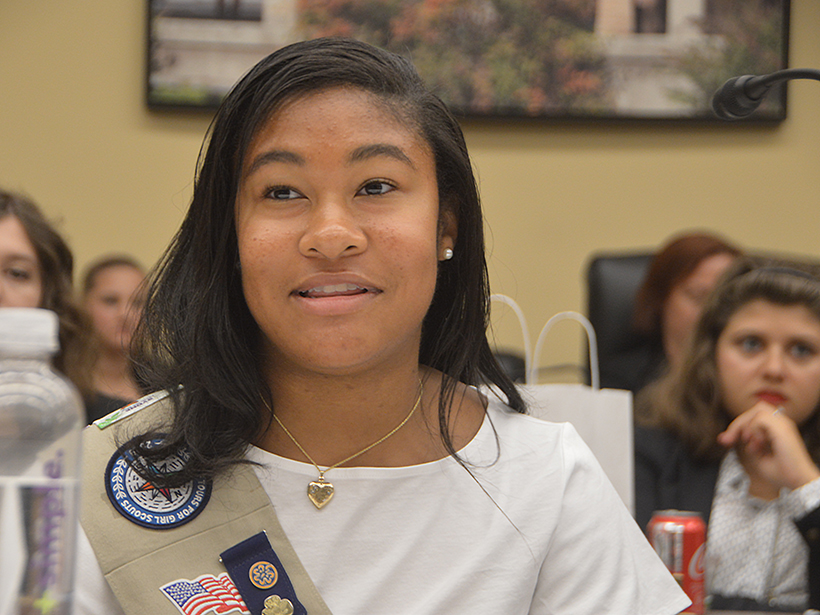Three years ago, when Sydne Jenkins was 13, her experience at the Girl Scouts Space Academy in Huntsville, Ala., helped fuel her interest in science. The academy “opened my eyes to the wondrous world of space,” said Jenkins, now a rising high school junior in Delaware. The experience also improved her critical thinking, communication, and problem-solving abilities, added Jenkins while speaking at a recent event on Capitol Hill.
Now Girl Scouts USA (GSUSA) is expanding its focus on science, technology, engineering, and math (STEM) education, which includes the introduction of three new space science badges.
At a 24 July briefing on Capitol Hill, Girl Scout leaders, members of Congress, and others spoke about the importance of girls entering and staying in STEM fields.
“As the world becomes ever more reliant on technology to power our daily lives, Americans need to harness the unique insights, skills, and potential of girls in the STEM fields.”
As an organization, the Girl Scouts “has a long history of engaging girls in STEM activities and encouraging them to pursue their interest in science in and out of the classroom,” said Cole Grissom, GSUSA senior manager of digital content strategy. “As the world becomes ever more reliant on technology to power our daily lives, Americans need to harness the unique insights, skills, and potential of girls in the STEM fields.”
The new badges include the Space Science Researcher, aimed to help 6th–8th graders understand the properties of light and use that knowledge to better understand the Sun, stars, and other celestial objects. The Space Science Expert badge teaches 9th and 10th graders more about light and understanding the universe and humanity’s place in it. The Space Science Master, for 11th and 12th graders, goes deeper into exploring, observing, designing, and communicating space science discoveries.
The space science badges join three others introduced in July 2018 for younger children, who have already earned nearly 68,000 Space Science Explorer, Adventurer, and Investigator badges.
All six badges are part of a collaboration called Reaching for the Stars: NASA Science for Girl Scouts, which is funded by NASA’s Science Mission Directorate and led by the SETI Institute, an organization in Mountain View, Calif., whose mission includes exploring, understanding, and explaining the origin and nature of life in the universe. That collaboration also includes the Girl Scouts Astronomy Adventure Destination at the University of Oregon and Girl Scout Astronomy Club training at NASA’s Goddard Space Flight Center in Maryland.
Empowering Girls Through STEM Education
“Women are still vastly underrepresented in STEM fields,” said SETI Institute director of education Pamela Harman. “Exposing girls to these subjects in multiple formats and at different venues is vital to ignite their curiosity and to close this gap.”
Three members of the House Committee on Science, Space, and Technology, including committee chair Eddie Bernice Johnson (D-Texas), ranking member Rep. Frank Lucas (R-Okla.), and committee member Rep. Kendra Horn (D-Okla.), who said that she is a lifelong Girl Scout, attended the hearing.
STEM “has actually allowed girls to be more prominent in these male-dominated fields and in STEM careers in general.”
The Girl Scouts “empowers young women to explore, to achieve, and to understand that their potential isn’t limited by where they were born or who they are, or what their background is, but is beyond their wildest dreams, if we just give young women the tools to explore,” Horn said.
High schooler Jenkins, who has been a Girl Scout for most of her life, is an example of that empowerment.
Jenkins, who confided that she wants to become a pediatric dentist, said that although she doesn’t currently plan to go into space science for her career, her exposure to STEM education through the Girl Scouts has been important.
STEM “has actually allowed girls to be more prominent in these male-dominated fields and in STEM careers in general,” Jenkins said.
—Randy Showstack (@RandyShowstack), Staff Writer
Citation:
Showstack, R. (2019), Girl Scouts emphasize STEM education, Eos, 100, https://doi.org/10.1029/2019EO130873. Published on 12 August 2019.
Text © 2019. AGU. CC BY-NC-ND 3.0
Except where otherwise noted, images are subject to copyright. Any reuse without express permission from the copyright owner is prohibited.
Text © 2019. AGU. CC BY-NC-ND 3.0
Except where otherwise noted, images are subject to copyright. Any reuse without express permission from the copyright owner is prohibited.

